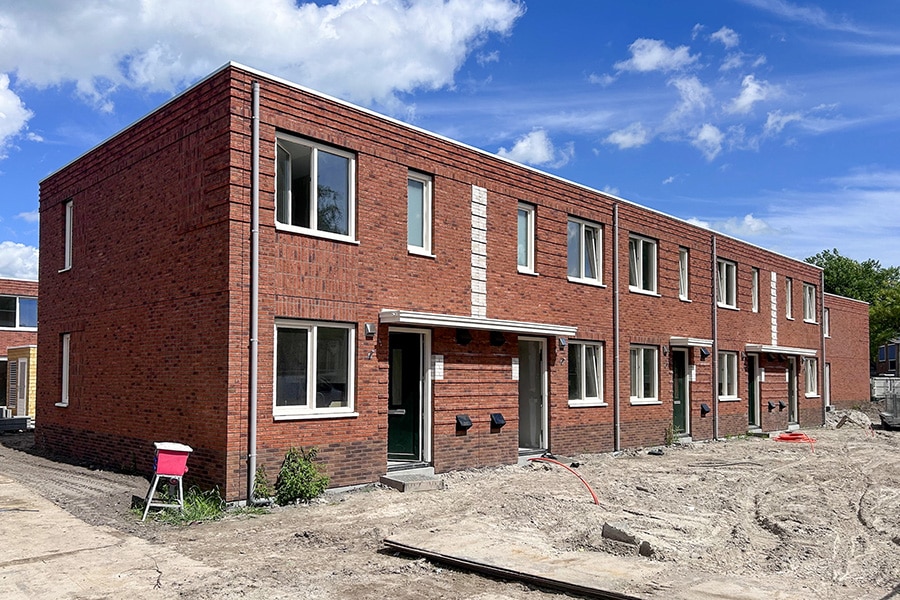
30% efficiency gains are achievable for every construction company
Like organizations in other industries, construction companies are under intense pressure today. From rising customer expectations to more complex projects, tight deadlines and reducing carbon emissions. Add to that the small margins in construction and you can understand that these are challenging times for most companies. Then, at first glance, it seems strange that construction is currently one of the least digitized industries. Especially when you know that the right approach can make construction processes as much as 30% more efficient.
Between 2020 and 2021, labor productivity in the construction sector increased slightly from 113 to 116%. In comparison, the industry saw an increase from 188 to 205% during the same period. Since an industry can only be profitable and viable from 100%, the curve for construction is particularly low. This stagnant productivity also has to do with the fact that companies in the construction sector mostly work on site and digitalization has not yet gone far on site.
So the good news is that there is plenty of room for improvement. Moreover, in most construction firms, we see the same problems cropping up. Manual (and often duplicative) work increases the cost and time of a project, while also increasing the risk of errors. A lack of transparency usually prevents companies from seeing where things go wrong, leaving them unable to address the root cause of a problem. And all those failures are not only pernicious for efficiency, but also for the organization's carbon emissions and carbon footprint.
Silos inhibit digitization
Provided the right approach is taken, an efficiency gain of 30% is possible in most construction processes. That figure comes from a combination of market research and benchmarks with our own clients. So why is the digitization of the construction industry proceeding so slowly? First, because many firms are still divided into silos. With different departments that have developed their own way of working over the years. As a result, information is also stuck in silos, which makes collaboration in the company inefficient and also puts a brake on digitization.
Meanwhile, the number of stakeholders in a project is also increasing, making access to real-time data only more important. Of course, most construction companies do already use various tools, but often those solutions only address a specific problem. The fact that we still regularly hear about companies compiling their data in an Excel sheet also proves that those tools are not aligned. If we really want to work more efficiently, we need to connect all the people and solutions in the company.
Bringing tools together via end-to-end solution
In this respect, we can make a comparison with our smartphone. Over the past decades, we have developed a device for all kinds of applications: a cell phone for calling and texting, a GPS for navigating, a personal digital assistant to manage the calendar, ... Eventually, these devices increasingly began to take over each other's functions. It was Apple that cleverly capitalized on this by combining everything into an end-to-end solution in the form of the first iPhone. Today, everyone has a smartphone that allows you to make calls, navigate, manage your calendar, and so much more.
In the construction industry, we are moving toward a similar evolution. An end-to-end platform as the backbone of digitization. A solution that connects all the tools, processes, data and people in a construction project. A system that ensures that everyone is working with the latest data and no more lists of outdated information circulating. In short, a cloud-based platform that merges silos and enables a higher level of automation.
New way of working
But as is often the case, mere technology is not enough. We must also look at the people and processes in the company. On the one hand, employees must see the added value of such a platform, and on the other hand, we must also change the way the company works. Automation usually brings up pain points, manual steps that take a lot of time today and are dropped in a digital age. For example, because certain data can be quickly extracted from an existing model. Therefore, we also need to redefine processes and engage people in a more meaningful way.
So once we have that digital backbone, all parties involved in a construction project can work together more efficiently. The result? Fewer delays, fewer frustrations and fewer unnecessary costs. End customers will also be better informed about the price tag of a major construction project, because we can connect all the data to the costing tool. In short, construction digitization is a win for everyone.




